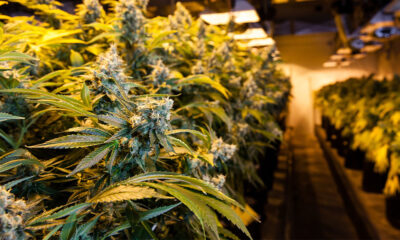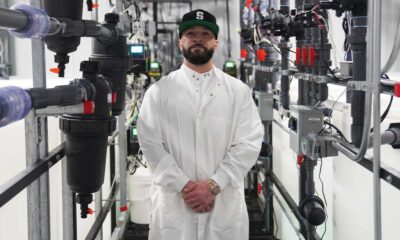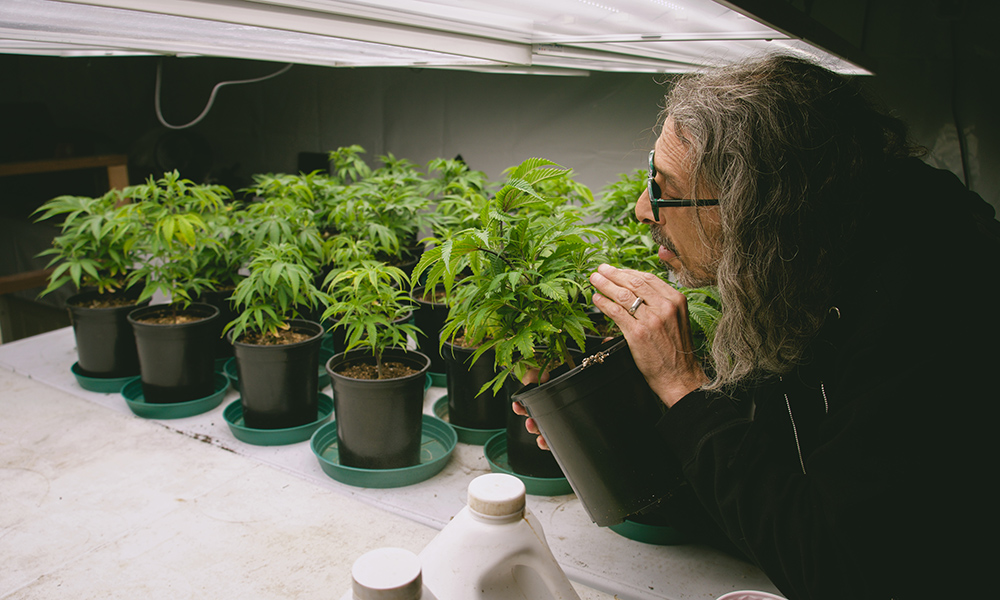
Sponsored
10 Ways to Improve Your Indoor Cannabis Grow’s Sustainability
Kyle Kushman offers advice on how to lessen your carbon footprint when growing marijuana inside.
It’s hard to believe that growing a plant can be detrimental to the environment. The issue isn’t the weed itself, but the methods and equipment we use to recreate Mother Nature. Outdoors, the sun and rain are free. Indoors, the sun needs to be replicated, and water needs to be transported. You can probably see where I’m going with this.
The problem faced by many indoor growers is reducing their carbon footprint. The question is, “Can it be done?”
Can we grow indoors in a more sustainable, regenerative way? Can our green be greener?
If you’re ready to make some changes—if you’re pumped at the thought of being a more conscientious grower—let’s go!
10 Steps Towards a Greener Grow
1. Grow Lamps
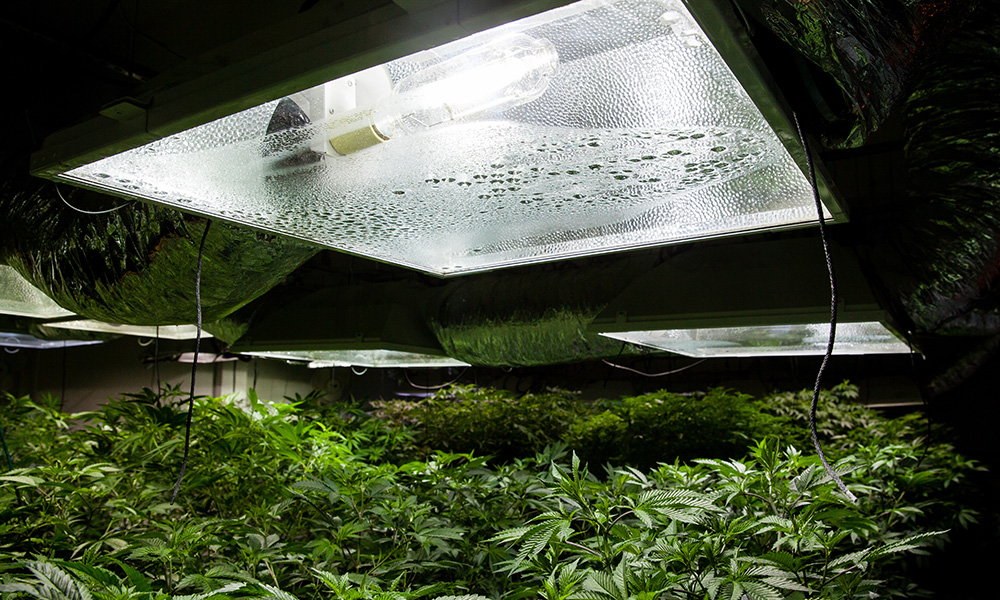
The traditional way to grow cannabis indoors is with High Intensity Discharge (HID) lamps, with either a Metal Halide (MH) or High Pressure Sodium (HPS) bulb. While HIDs are great at delivering the energy your plants need, they’re not very efficient. They produce a lot of heat and use a lot of power, and to add insult to injury, you’ll probably need additional fans and cooling equipment.
There’s an alternative to these power-hungry lights: LEDs.
A good, modern LED grow lamp uses far less energy than HIDs, while delivering a better light spectrum, switching from vegging to flowering with the touch of a button. They run much cooler and weigh less. The problems are cost and having too many choices—you’ll need to do your research, as it’s a new market with an abundance of bad products.
That said, if you source a really good set of LEDs, they’ll make your grows less expensive, easier to manage, and more environmentally friendly.
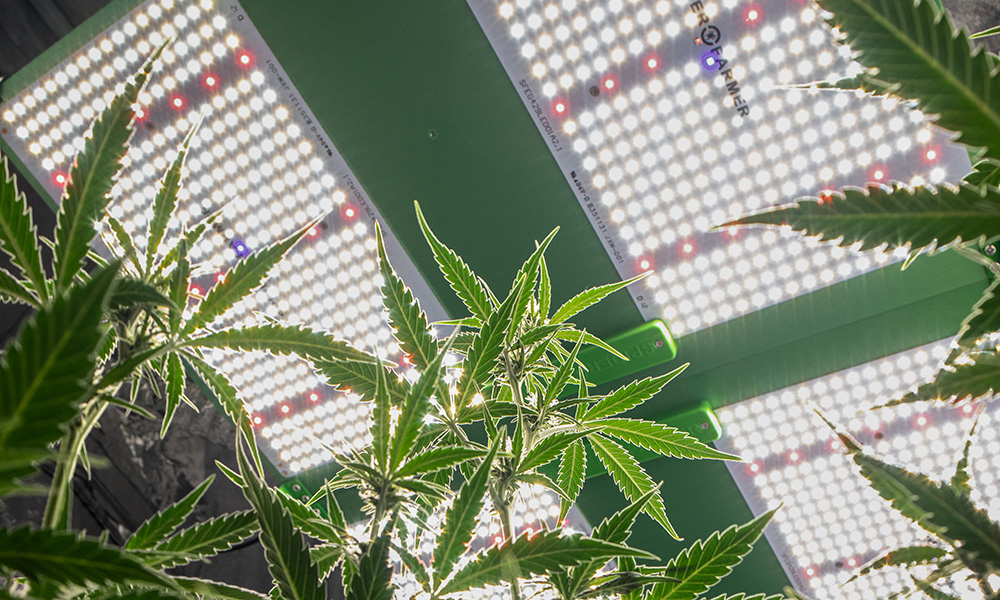
However, LEDs aren’t the only answer.
You can, at least partially, swap out your lamps for natural light. Your seedlings or young clones will be fine on a windowsill for the early stages of life. They’ll appreciate the soft light, and your tent can stay powered down a few weeks longer than normal.
If you have big windows with plenty of sun, you can extend this no-lamp period well into veg, using your grow lights only when the sun goes down.
Key Takeaways:
Cost: Good LEDs are expensive, but they’ll start saving money immediately. No need for additional cooling and no more huge power bills.
Impact: Yes, there’s a cost, but what an impact! You’ll be doing the planet a BIG favor by switching to LEDs—they’ll reduce your energy consumption by at least 50%.
2. Cultivars
How can the choice of cultivar make a difference to your energy consumption? Quite easily, in fact—and not just in terms of energy. Choosing the right seeds can deliver savings across the board.
Take a huge sativa like Homegrown’s Purple Thai, for example. This heavy-yielding beast, while being super-productive, will spend a lot of time in the tent.
You’ll want to give her a good vegging period in addition to at least 12 weeks in flower, maybe even the full 14.

Compare this to one of Homegrown Cannabis Company’s Fast Version seeds: Bruce Banner. This plant will deliver up to 21oz/m2 indoors, but will spend a mere 6 – 8 weeks in flower.
A quick calculation shows a potential reduction of eight weeks in the tent (eight weeks is a lot of fertilizer, water, power and work).
Autoflowers are a step up again. Some autos finish their entire cycle in 8-10 weeks, though you’ll have to put in extra work to pull decent yields.
If you want to learn how to MAX your yields from autos, watch this Kronic’s revegging video.

Key Takeaways:
Cost: Fast Version and Auto seeds cost pretty much the same as your standard fems, but the money they can save is huge.
Impact: With such a reduced growing time, you’re going to lower your carbon footprint massively. You’ll really cut down your workload, too—less time growing, more time toking!
3. Automation
There are still indoor growers who don’t use a timer for their lights. That little plug-in device has saved me a fortune.
People often ask, “It turns your lights on and off, what’s the big deal?”
Well, it’s no big deal, until you forget to do it yourself—until you kill all your plants and have to begin again. Starting over is both a huge cost and a massive waste of money—not to mention heart breaking!
But a simple timer is just the start. You can automate all your equipment to switch on only when needed. This includes ventilation, humidifiers, C02, feeding and watering… there’s not much to growing you can’t automate these days!
You might not have the budget of a 2000-acre commercial grow, but you can work to scale by starting with a simple timer.
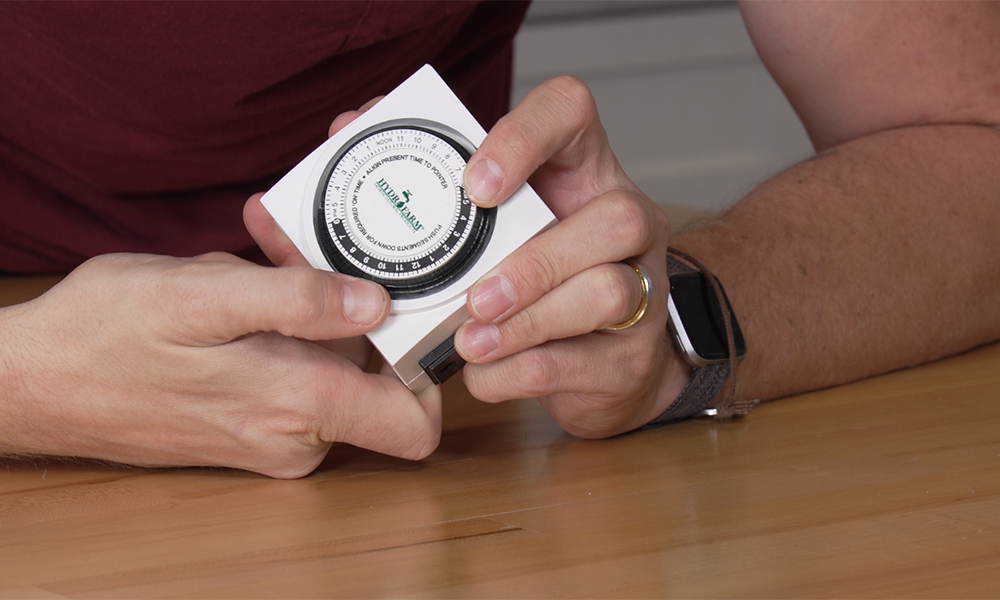
Key Takeaways:
Cost: The cost will only be determined by how much automation you wish to integrate. Timers are cheap; full AI-driven automation is expensive. Only you know how deep your pockets are.
Impact: The marginal gains offered by automation can add up to huge benefits, both for your plants and for the environment. The biggest attractions for me are the reduction of man-hours and the lowered risk of user error. There’s little more devastating than a ruined grow.
4. Fertilizers and Pest Control
There’s an obvious way to improve your environmental impact here: Go organic! Or, even better: veganic!
Be as natural, organic and regenerative as you possibly can. When you use standard, non-organic nutrients, you’re delivering feed in the form of salts. As a salt, the nutes are soluble and easier to uptake.
But there is a price.
Salts accumulate in the soil and eventually make it less fertile, reducing the ability of plants to uptake nutrients.
The answer? Always choose veganic/organic nutrients.
The added bonus of Veganix is they’re almost 100% completely free of heavy metals. Not even the best organic nutes can claim that! You need to find natural solutions for pesticides, too. While most organic pesticides aren’t completely free of chemicals, their ingredients are derived from natural sources and break down more quickly.
Nikki and Swami, Homegrown’s Outdoor Experts, know a thing or two about regenerative gardening. Here’s what they have to say about feeding your cannabis plants:
“We use chicken manure and even alpaca manure from our neighbor up the hill. We have also used alfalfa meal, sea kelp, wood chips, leaves, compost, worm castings, as well as rock phosphate, green sand, gypsum, and azomite in small amounts. You can be part of restoring the earth by your choices. When growing your own medicinal or inspirational cannabis, you naturally want it to be pure, organic and non-harmful, with a small carbon footprint.”
The benefit of feeding organically or veganically, apart from the clearer conscience, is the quality of your plants. The more natural the grow, the tastier, stronger and healthier your plants will be.
Key Takeaways
Cost: Organic fertilizers tend to be more expensive than their standard counterparts. If you have the time and resources, however, you can build your own compost and create your own amendments. You’ll be able to grow knowing your impact on the environment is reduced, which should help you sleep at night—just like a nice, potent indica.
Impact: Every grower who chooses organic pesticides, fertilizers and amendments is making a difference. The organic movement has taken great leaps over the last few decades, and it couldn’t have done so without the buy-in, support and commitment of honorable and scrupulous growers.
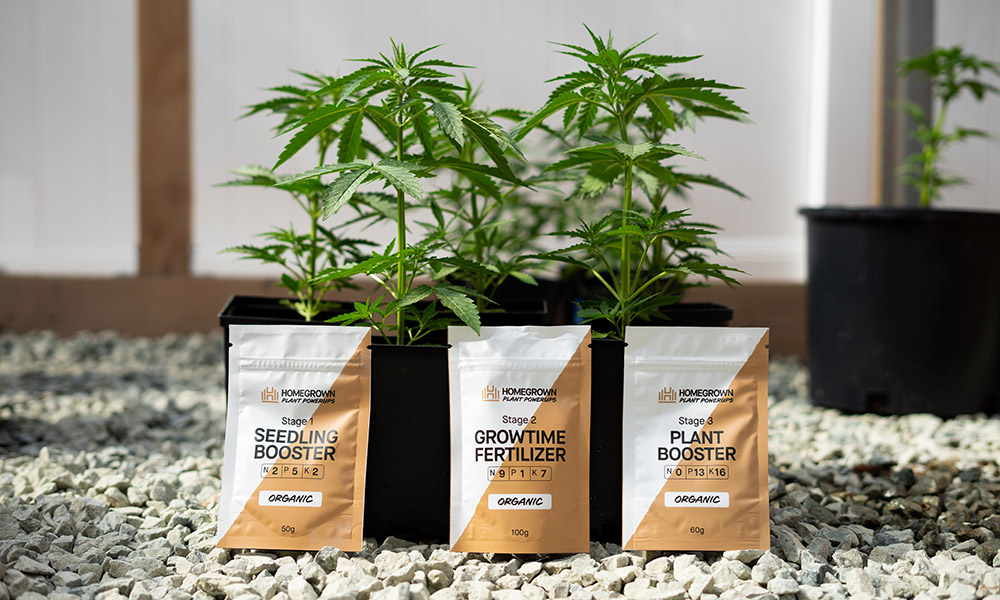
5. Hydroponics.
Believe it or not, hydro grows use far less water than soil grows. Here’s why:
- Soil grows need watering every few days, and a big proportion of the water is lost to evaporation and leaks.
- Most hydro set-ups take advantage of a recirculating nutrient reservoir: The plants only use water they need and hardly any is lost or wasted.
- A good hydro grow will use up to 90% less water than a soil grow.
- Hydro grows take up less room, meaning a smaller space to heat, treat or air condition.
- They’re far less prone to pests and pathogens, reducing the use of pesticides.
- Plants grow more quickly in hydro, consequently lowering energy use.
- You’ll probably end up with bigger yields, too!
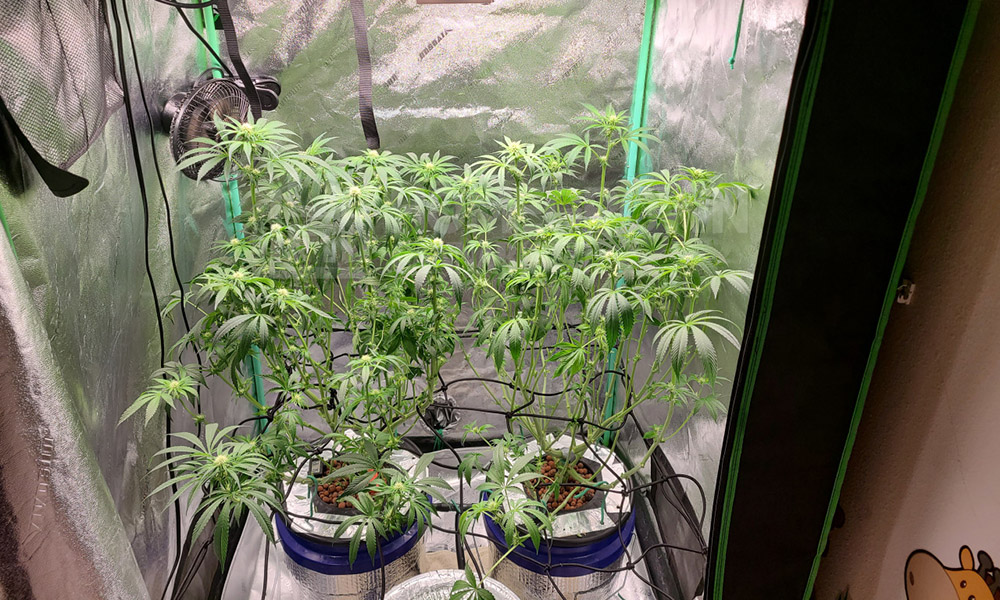
There are drawbacks, of course.
You’ll need to buy additional equipment and you’ll need to know what you’re doing, but if you can nail hydro you’re looking at big environmental savings – right across the board.
Key Takeaways:
Cost: More equipment means more money, and your water savings won’t benefit your wallet to the same extent as LEDs or Fast Version cannabis seeds.
Impact: Water is a hot topic. From the absurdity of bottled water to global shortages in both the developed and developing world, we must start being more responsible. Growing in a hydro set-up is only part of the solution—sourcing your water is next.
6. Water, Water

You can make two major changes when it comes to watering: First is sourcing your water and second is perfecting your watering technique.
Let’s break down the water sources available to most growers:
- Bottled water: The carbon footprint of bottled water is staggering. On average, it takes 10 gallons of water to produce one gallon of bottled water. This option should never be on the table.
- Tap water: While it’s relatively inexpensive, it often needs dechlorinating, and the ppm might need lowering to “make room” for the nutes. You can do the former by letting the water stand in a large bucket overnight, and the latter by using a Reverse Osmosis (RO) machine.
- Reuse old water and collect your rainwater: From a simple bucket under a drain to greywater diverters (water from showers, bathtubs, dehumidifiers, etc.), you can really go to town on conservation. Though you will need an RO machine, a water-preserving garden is great for your pocket and the planet. If everyone reused their rain and greywater, it would save billions of gallons every year.
What about technique? If you cycle wet to (almost) dry, you’ll minimize wastage while creating the strongest possible root ball. It works like this: You drench the plants with plenty of water, then allow the soil to almost dry. As the moisture recedes, the roots chase outwards, following the water. When the pot is almost dry, you drench again.
Key Takeaways:
Cost: As with automation, your costs will depend on how far you can go. A bucket under a drain is cheap; a full irrigation system could be expensive.
Impact: Your plants drink a lot of water. If you source it responsibly and feed your plants properly, it can have a huge impact on the sustainability of your garden.
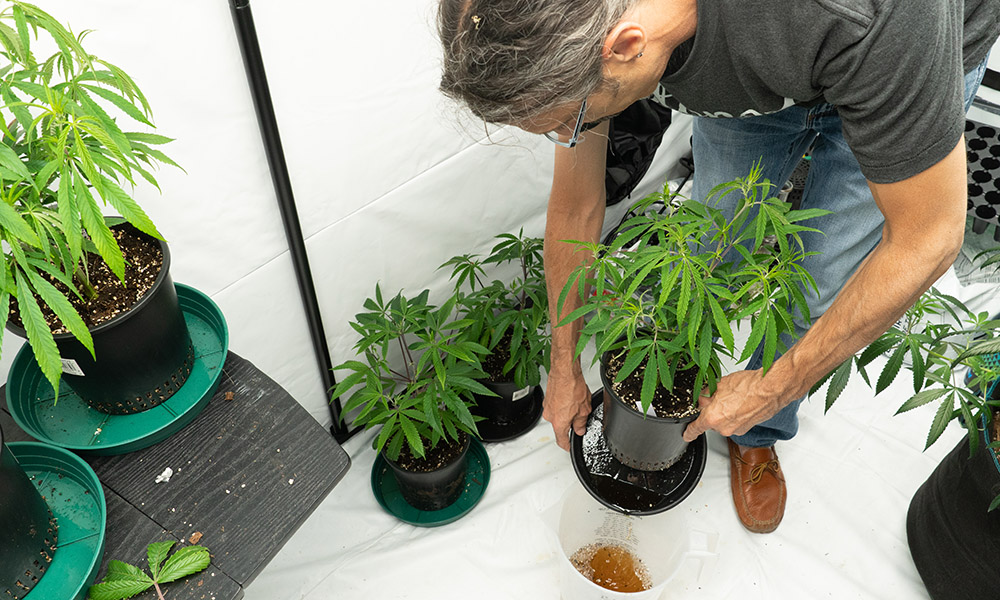
7. Carbon Dioxide
Plants love carbon dioxide. If you want to deliver your C02 more sustainably, try swapping out those huge cylinders, tanks and delivery kits for a bag of spores.
Companies are producing bags of mycelium that feed off a substrate in a self-contained bag, pumping out C02 in the process. They’re lightweight, cheap, easy to use and can increase average yields by 20-30% (compared to no additional C02).
Key Takeaways:
Cost: You’ll save plenty of cash switching to C02 bags, and they’re easier to carry home from the garden center!
Impact: It takes a lot of haulage to move those huge tanks around—your little bags of mycelium have a much smaller footprint.
8. Airflow
Optimizing airflow can have positive repercussions in terms of energy efficiency and plant health. Good airflow can:
- Balance fluctuations in humidity and temperature.
- Cool down the “hot spots” beanth the lights.
- Stop the air from stagnating, which is extremely important in terms of preventing pests, mold and nutrient lock-out.
The easiest way to optimize airflow is to position two oscillating fans at opposite ends of the plants. Place one to blow under the lamps, and the other to blow under the canopy in the opposite direction.
Be careful not to blast the air. You are aiming for a gentle circulation that cools, strengthens and prevents stagnation. You’ll notice the difference immediately.

Key Takeaways:
Cost: Negligible. You should already own a couple of fans—this is about using your existing equipment more efficiently.
Impact: Optimizing airflow is a super-quick win and one you should take action on right now.
9. Passive Air Intake
Your plants will suffer with no ventilation in the tent. Fresh air is essential for photosynthesis and respiration. There’s more than one way to achieve this, but the method with the smallest environmental impact is to intake air as passively as possible.
Note: A passive air intake system is typically only applicable to smaller grows, but it can save on energy and equipment.
Rather than using an intake fan to draw air from outside the tent, a passive system relies on natural airflow through vents and holes in the tent. An open window close to the vents plus active fans will help replace the warmer air coming out of the tent. Using your fans correctly will help, too!
Key Takeaways:
Cost: Cheaper than using intake fans, but not nearly as effective.
Impact: Lowers your energy use and reduces your carbon footprint.
10. Seed Supplier

I’ve saved this one for last, as it’s by far the easiest step you can take. We should be aware not only of our own carbon footprint, but also the environmental impact of the companies we choose to deal with.
A huge number of Americans insist on buying cannabis seeds from Europe, and it’s hurting the environment. Homegrown Cannabis Co dispatches their seeds from California, massively reducing the number of air miles needed to deliver the goods.
Ask yourself this simple question: Is it worth ordering from overseas, waiting longer for delivery, and risking seizure at the border? Are European seed banks really that much better than American companies?
How many European seed banks are supported by Steve DeAngleo, Nikki Lastreto, Swami Chaitanya, Eric Brandstad, Ricky Williams, the Dank Duchess and myself? None.
Buy American. Make America green again.
Key Takeaways:
Cost: Homegrown’s prices are highly competitive, and they always have great offers.
Impact: A train from California or a plane from Catalonia? You do the math.
Your Tent, Your Decisions, Your Future
Growing cannabis indoors is an amazing, extremely rewarding experience. Growing your own gives you the power to grow sustainably and to make better decisions for your buds, your bowl and your planet.
Please go through these steps again, think about what you can be doing better, what quick changes you can make, and how you’d like to improve your future grows. Remember: Growing cannabis indoors doesn’t have to cost the earth.



